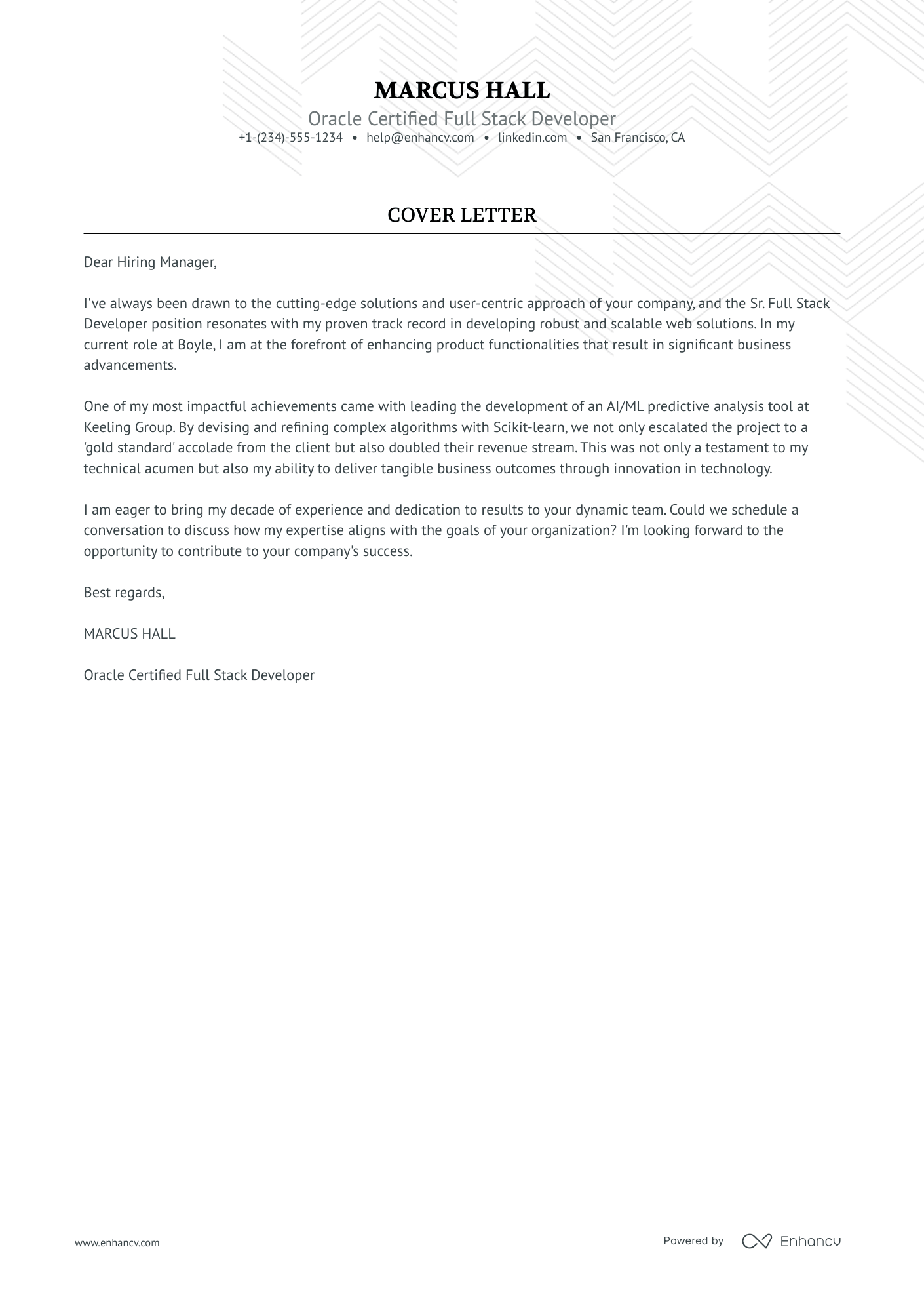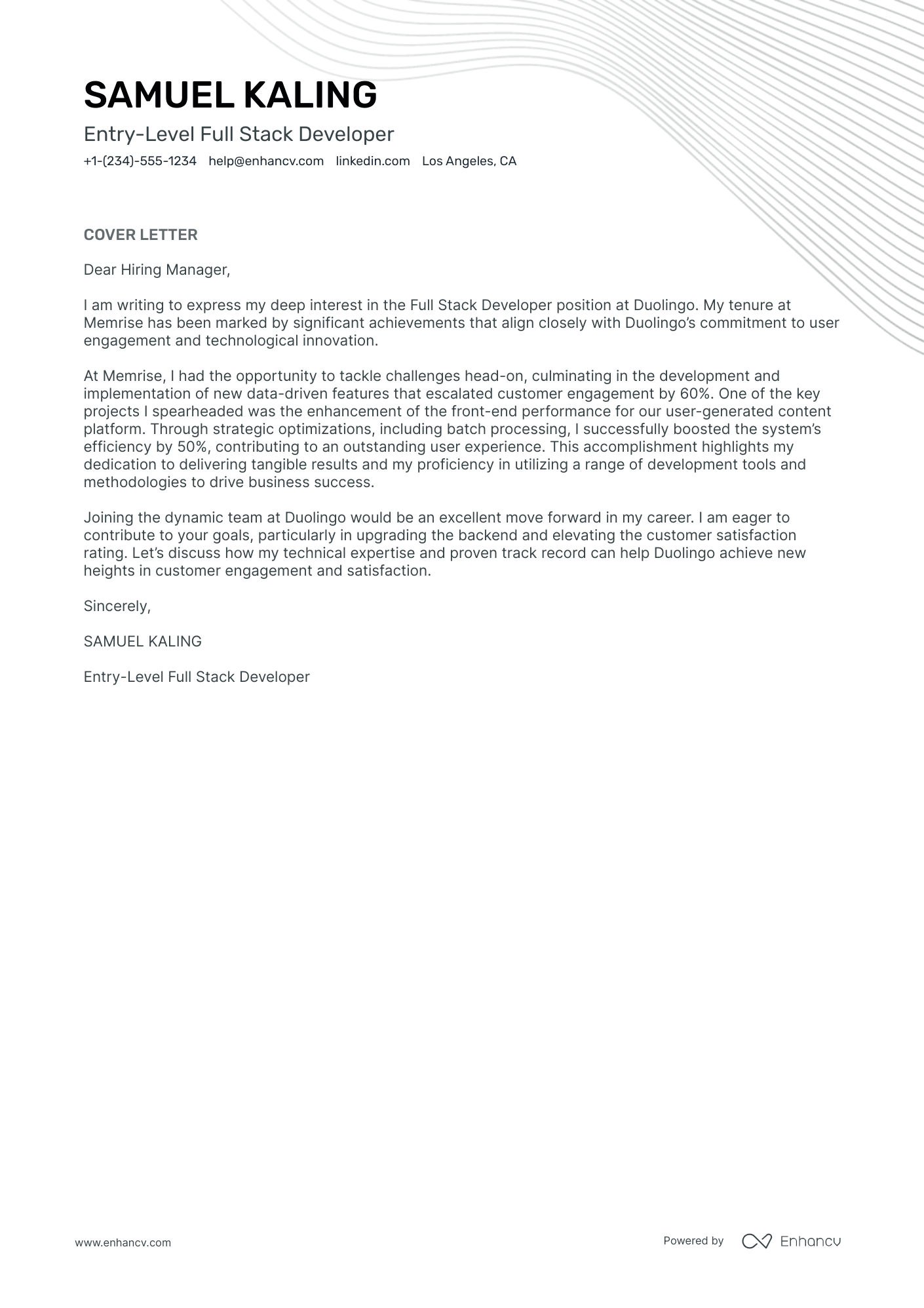Embarking on your job search, you may have quickly realized that a compelling full stack developer cover letter is a must-have to accompany your resume. Yet writing one can be tricky—it's not about rehashing your CV, but rather weaving a narrative around your proudest professional triumph. We'll guide you on striking the right balance between formality and freshness, steering clear of clichés, and keeping it succinct, all within a single page. Let's start crafting a letter that tells your story with impact.
- Create a full stack developer cover letter to persuade the recruiters you're the best candidate for the role;
- Use industry-leading full stack developer cover letter templates and examples to save time;
- Dedicate your full stack developer cover letter space to your best achievement;
- Make sure your full stack developer cover letter meets recruiters' expectations and standards.
Avoid starting at the blank page for hours by using Enhancv's AI - just upload your resume and your full stack developer cover letter will be ready for you to (tweak and) submit for your dream job.
If the full stack developer isn't exactly the one you're looking for we have a plethora of cover letter examples for jobs like this one:
Drop your resume here or choose a file.
PDF & DOCX only. Max 2MB file size.
Full stack developer cover letter example
MARCUS HALL
San Francisco, CA
+1-(234)-555-1234
help@enhancv.com
- Certification Mention: The cover letter smartly mentions the "Oracle Certified Full Stack Developer" certification, which aligns with the specialized role of Sr. Full Stack Developer and displays a level of professional qualification and commitment to the field.
- Technical Achievements: By citing the development of an AI/ML predictive analysis tool and the use of Scikit-learn, the candidate showcases their advanced technical skills and experience with complex projects, which is crucial for a senior position.
- Quantifiable Success: The writer emphasizes an achievement that had a measurable impact on business outcomes — doubling the client's revenue stream. This highlights the candidate's ability to translate technical work into concrete business value, a highly desirable trait in a senior developer.
- Call to Action: The closing paragraph contains a direct invitation to schedule a conversation, steering the application towards the next step and demonstrating proactiveness and eagerness to engage with the hiring team.
Designing your full stack developer cover letter: what is the best format
Let's start with the basics, your full stack developer cover letter should include your:
- Header
- Greeting
- Introduction
- Body paragraph
- Closing statement
- Signature (that's not a must)
Next, we'll move to the spacing of your full stack developer cover letter, and yes, it should be single-spaced (automatically formatted for you in our cover letter templates).
Don't go for a old-school font (e.g. Arial or Times New Roman), but instead, pick an ATS-favorite like Chivo, Volkhov, or Raleway, to stand out.
Our cover letter builder is also set up for you with the standard one-inch margin, all around the text.
Finally, ensure your full stack developer resume and cover letter are in the same font and are submitted in PDF (to keep the formatting in place).
P.S. The Applicant Tracker System (or ATS) won't be assessing your [job] cover letter, it's solely for the recruiters' eyes.
Skip the hassle of writing a cover letter. Use our free cover letter generator and get it done in moments.
The top sections on a full stack developer cover letter
- Header: This includes your contact information and the date, ensuring the recruiter can easily reach out to you and knows when the correspondence was sent.
- Greeting: It's important to address the recruiter or hiring manager by name if possible, as it shows you have done your research and are genuinely interested in the position at their company.
- Introduction: In this section, you should succinctly capture the recruiter's attention, mentioning your experience as a full stack developer and your enthusiasm for the role you're applying for.
- Technical Experience: Use this section to highlight your specific skills in front-end and back-end development, including programming languages, frameworks, and projects you've worked on, which are crucial for a full stack developer role.
- Closing: Here you will reiterate your interest in the role, thank the recruiter for considering your application, and indicate your availability for an interview, signaling your eagerness to discuss how your skills align with the company's needs.
Key qualities recruiters search for in a candidate’s cover letter
- Proficiency in both front-end and back-end technologies: Full stack developers must be adept at working with a range of technologies like JavaScript, CSS, and HTML for front-end, as well as Node.js, Python, Ruby, or Java for back-end development. This demonstrates their ability to handle all aspects of web development.
- Experience with full project lifecycle: Employers look for candidates who have seen projects through from conception to deployment, showing they can manage and understand all development stages.
- Knowledge of database management: Full stack developers often need to interact with databases, so experience with SQL, NoSQL, or specific systems like MySQL, PostgreSQL, or MongoDB is highly valued.
- Familiarity with version control/Git: This is crucial for collaborating with team members and maintaining the integrity of a project’s codebase.
- Understanding of web design principles: Having a keen eye for design and user experience is important since full stack developers will work on the front end and need to ensure the application is both functional and appealing.
- Problem-solving attitude: The ability to troubleshoot issues across the stack and come up with effective solutions is critical for a full stack developer, highlighting their ability to address challenges in any layer of the stack.
How to address hiring managers in your full stack developer cover letter greeting
Goodbye, "Dear Sir/Madam" or "To whom it may concern!"
The salutation of your full stack developer cover letter is how you kick off your professional communication with the hiring managers.
And you want it to start off a bit more personalized and tailored, to catch the recruiters' attention.
Take the time to find out who's recruiting for the role (via LinkedIn or the company page).
If you have previously chatted or emailed the hiring managers, address them on a first or last name basis.
The alternative is a "Dear HR team" or "Dear Hiring Manger", but remember that a "Dear Ms. Simmons" or "Dear Simon," could get you farther ahead than an impersonal greeting.
List of salutations you can use
- Dear Hiring Manager,
- Dear [Company Name] Team,
- Dear [Department Name] Hiring Committee,
- Dear [Mr./Ms.] [Last Name],
- Esteemed Colleagues,
- Respected Hiring Professionals,
The full stack developer cover letter introduction: focusing on your unique value, with a creative twist
You are not the only one wondering how to start your full stack developer cover letter. Those first two sentences introduce your profile and should be memorable.
No pressure.
When beginning your full stack developer cover letter, immediately point out the unique value of working with you. In other words, what you promise to bring to the role by using your past track record of success.
Start your full stack developer cover letter with a creative twist by telling a joke or stating something relatable. Select this type of introduction only if it aligns with the company culture.
What to write in the middle or body of your full stack developer cover letter
Here's where it gets tricky.
Your full stack developer cover letter body should present you in the best light possible and, at the same time, differ from your resume.
Don't be stuck in making up new things or copy-pasting from your resume. Instead, select just one achievement from your experience.
Use it to succinctly tell a story of the job-crucial skills and knowledge this taught you.
Your full stack developer cover letter is the magic card you need to further show how any organization or team would benefit from working with you.
Closing paragraph basics: choose between a promise and a call to action
You've done all the hard work - congratulations! You've almost reached the end of your full stack developer cover letter.
But how do you ensure recruiters, who have read your application this far, remember you?
Most full stack developer professionals end their cover letter with a promise - hinting at their potential and what they plan on achieving if they're hired.
Another option would be to include a call for follow-up, where you remind recruiters that you're very interested in the opportunity (and look forward to hearing from them, soon).
Choose to close your full stack developer cover letter in the way that best fits your personality.
What could you write about in your full stack developer cover letter when you have no experience
Candidates with zero professional experience often struggle to write their full stack developer cover letter.
You may lack experience, but your application could still be impressive when you focus on your strengths.
Consider your most relevant talents (and/or one achievement) that align with the role and help you stand out.
Perhaps you spent every summer volunteering at your local dog pound - think of the job-relevant skills this experience taught you.
Sharing your tangible career goals is another good strategy to stand out.
Key takeaways
Turning your full stack developer cover letter into a success is all about staying authentic to yourself and relevant to the job:
- Be creative with your full stack developer cover letter introduction by stating something you enjoy about the company (that is genuine) or about your skill set (to get the recruiters' interested);
- Use single spacing and have a one-inch margin wrapping all around the content of your full stack developer cover letter;
- Select just one past achievement from your career or life to tell a story of how you've obtained job-crucial skills and how they'd be beneficial to the role;
- The finishing paragraph of your full stack developer cover letter doesn't necessarily have to be a signature but could be a promise of what you plan to achieve in the role;
- Instead of focusing on your lack of experience, spotlight your transferable skills, one relevant achievement, and career dreams.
Full Stack Developer cover letter examples
By Experience
Junior Full-Stack Developer
Senior Full-Stack Developer
Entry-Level Full-Stack Developer
By Role



















